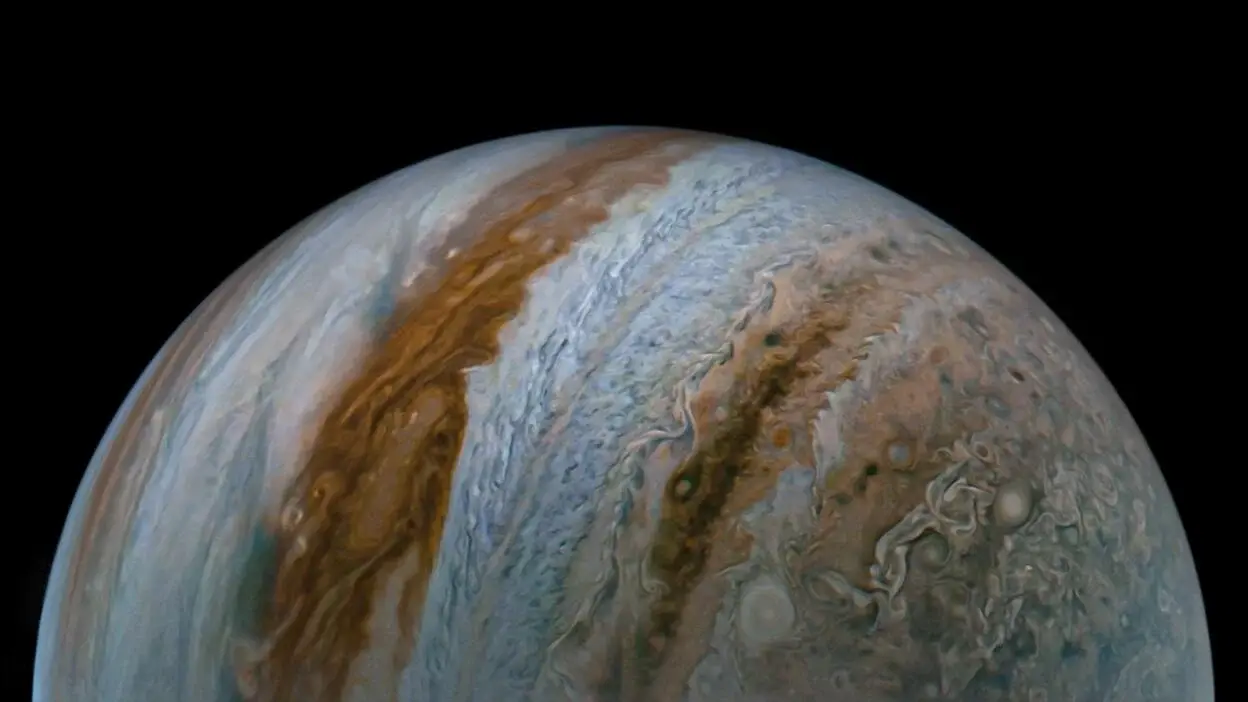Science
Jupiter’s Influence: Key to Earth’s Habitability Revealed by Study

A recent study from Rice University in Houston highlights the significant role that Jupiter played in Earth’s development, suggesting that without this massive gas giant, early Earth may have drifted too close to the Sun, making it incapable of supporting life. This research, published in the journal Science Advances, emerged from an ongoing investigation into the formation timeline of solid objects in the solar system.
Scientists have long puzzled over why the earliest solid materials in our solar system did not form simultaneously. Evidence from meteorites indicates the presence of two distinct generations of planet-building materials. The first group appeared within the first million years, while the second group that contributed to rocky planets like Earth, Mars, and Venus formed 2 to 3 million years later. The study’s authors sought to understand how enough dust remained for this second generation, leading them to conduct detailed computer simulations of the young solar system.
The findings point to Jupiter as a critical factor influencing this timeline. Today, Jupiter’s mass is greater than that of all other planets in the solar system combined. Prior to this research, no model existed that sufficiently explained the age difference between these ancient materials. The study represents a comprehensive approach by integrating how Jupiter’s formation, the movement of dust, and the development of asteroids interacted over time.
As the researchers discovered, Jupiter’s immense gravity not only prevented Earth and its neighboring planets from migrating inward but also likely restricted their growth by limiting their access to materials from the outer solar system. Baibhav Srivastava, a planetary scientist and co-author of the study, stated, “Our Earth might have become a ‘super-Earth.’ This may have significant implications for the potential habitability of Earth as well, since it may have left the ‘Goldilocks’ zone of the solar system.”
The “Goldilocks zone” refers to the area around a star where conditions are just right for liquid water to exist, a crucial factor for life. Jupiter’s gravitational influence is often termed as making it the architect of the solar system, as it shaped the orbits of other planets and organized the gas and dust from which they formed.
As Jupiter grew, it altered the environment around the Sun, draining gas from the inner region and creating pressure ridges that effectively corralled dust into clumps. These so-called “dust traps” facilitated the formation of new solid objects long after the initial ones, providing a plausible explanation for the age gap observed in rocky materials.
The timing of this second material generation aligns with that of ordinary chondrites, the most common type of stony meteorite found on Earth. Researchers estimate the ages of these meteorites’ parent bodies by measuring isotopes within them. Through this method, scientists can determine when the rock solidified, similar to carbon dating but using heavier elements like lead and strontium.
By the time the second wave of rocky material solidified, Earth was already forming. Therefore, this later generation likely had minimal impact on the planet’s development. The study also suggests that Jupiter’s formation occurred extremely early, within the first 2 million years of the solar system, allowing it sufficient time to shape the surrounding gas and dust.
These findings resonate with current observations from astronomers studying other young star systems using advanced telescopes. André Izidoro, an assistant professor at Rice University and co-author of the study, commented, “Looking at those young disks, we see the beginning of giant planets forming and reshaping their birth environment. Our own solar system was no different. Jupiter’s early growth left a signature we can still read today, locked inside meteorites that fall to Earth.”
In summary, the study underscores Jupiter’s vital influence on the conditions necessary for life on Earth. As researchers continue to explore the intricate dynamics of our solar system’s formation, the implications of Jupiter’s role may further illuminate our understanding of how planetary systems develop and the requirements for habitability.
-

 Health6 days ago
Health6 days agoRare Brain Condition Discovered More Common in New Mexico
-

 Politics1 week ago
Politics1 week agoPrince Andrew Steps Back from Royal Duties Following Epstein Memoir
-

 Entertainment1 week ago
Entertainment1 week agoTrump Commutes George Santos’ Sentence, Sparks Controversy
-

 Sports1 week ago
Sports1 week agoMLS Decision Day 2025: Playoff Spots on the Line as Teams Clash
-

 World1 week ago
World1 week agoYoung Driver Dies in Collision with Box Truck in El Cajon
-

 Health1 week ago
Health1 week agoRemembering Mary Ingleby: A Life of Love, Teaching, and Music
-

 Science1 week ago
Science1 week agoIdaho State University Launches Haunted Science Laboratory on Oct. 25
-

 Politics1 week ago
Politics1 week agoNavy Veteran Max Quattromani Launches Campaign for Assessor Seat
-

 Lifestyle1 week ago
Lifestyle1 week agoKent Hamilton Named Southeastern Farmer of the Year at Expo
-

 Sports1 week ago
Sports1 week agoSaquon Barkley Reacts to James Franklin’s Dismissal from Penn State
-

 Health1 week ago
Health1 week agoFDA Introduces First Nine Recipients of National Priority Vouchers
-

 Health6 days ago
Health6 days agoScientists Warn: Human Brain Struggles to Function After Midnight









